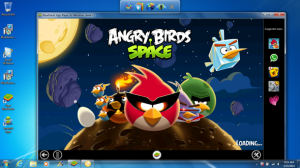Run Android apps on Windows with BlueStacks

So you love Draw Something, Air Attack HD, or some other Android application? If you wanted to run that or any other Android app on your Windows PC, you were out of luck – until recently. BlueStacks now makes it possible to run Android applications on Windows systems.
While still in beta, the BlueStacks App Player delivers the goods. I've only tinkered with it myself, but everyone I know who uses it a lot think it's great.
It's not just we techies who like BlueStacks. What's more telling is that PC-giant ASUS has signed a deal with BlueStacks to include its Android app player on the company's next generation PCs, including the models running Windows 8,
Since Microsoft plans to make it difficult to dual-boot or root any other operating system on Windows 8 systems and to make it impossible to add or switch operating systems on Windows RT (Windows 8 on ARM) tablets and phones, BlueStacks likely will be the only way to run Android applications on Windows 8 PCs, tablets, and smartphones.
BlueStacks does this not by using a virtual machine (VM) as such but by running an emulation of the Android Davlik (also a VM) on top of Windows. While BlueStacks plans to patent some of the technology in its Android emulator, LayerCake, the technique dates back for decades.
The most well-known modern emulator is Wine. This popular open-source program, along with its commercial brother, CrossOver, enables Linux, Mac OS X, and other Unix users to run Windows applications. It does this by bridging the gap between the Windows program's application programming interface (API) calls and the underlying operating system.
Like Wine, BlueStacks doesn't emulate the actual hardware of a device. Instead, it emulates just enough of Android Davlik to server as a bridge between the application and Windows' APIs. Besides leveraging the Windows device's processor, be it x86 or ARM, BlueStacks can access the system's graphics hardware to accelerate the program's graphics processing. LayerCake also duplicates Android device's accelerometer tilting in applications and games that utilize it with the mouse or arrow keys. Pinch-to-zoom is also supported on mouse trackpads.
BlueStacks also has a related application, Cloud Connect, which lets you sync Android apps from your phone or tablet to a PC running BlueStacks App Player.
While this sounds pretty spiffy—and indeed it is—I have to add that it raises security concerns. True, BlueStacks has its own App Store, but we all know that people find a way to install other applications. Indeed, Cloud Connect, while very useful, is also an easy road for malware. And, in case you haven't been paying attention, there's a lot of Android malware on the loose.
Still, if you're careful with your Android downloads and you really like the idea of having your favorite Android apps on a Windows PC, BlueStacks can't be beat. The company also plans to bring its technology to Mac OS X as well, though I wouldn't count on seeing that anytime soon. BlueStacks will have its hands full getting ready for the launch of Windows 8.
Related Stories:
ASUS to preinstall BlueStacks on PCs: Android on Windows
CNET: Latest BlueStacks ARMs your PC
